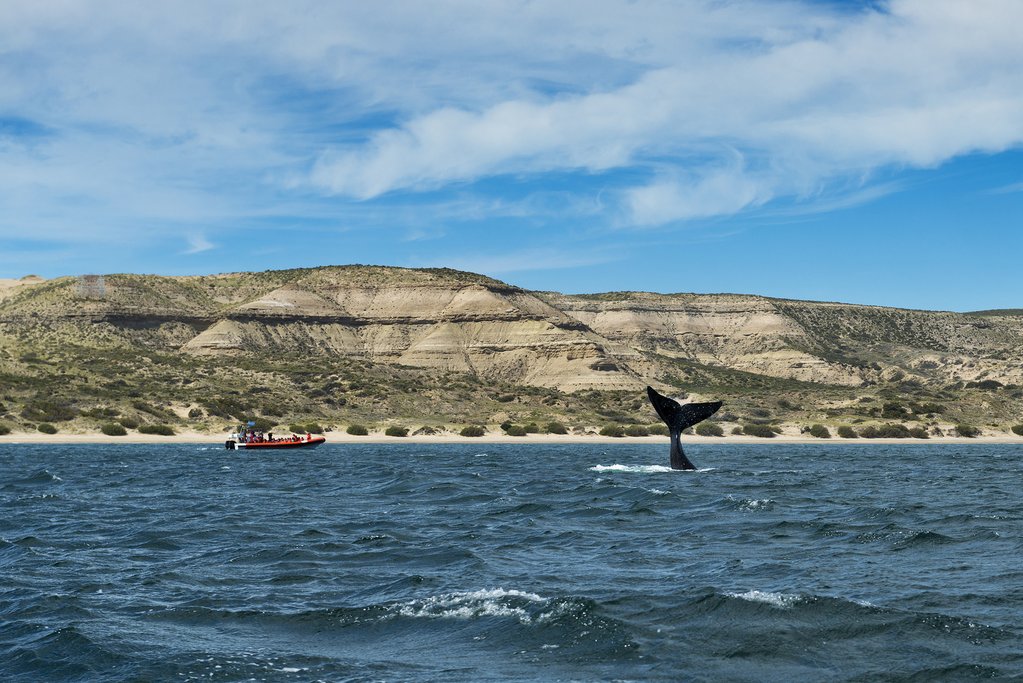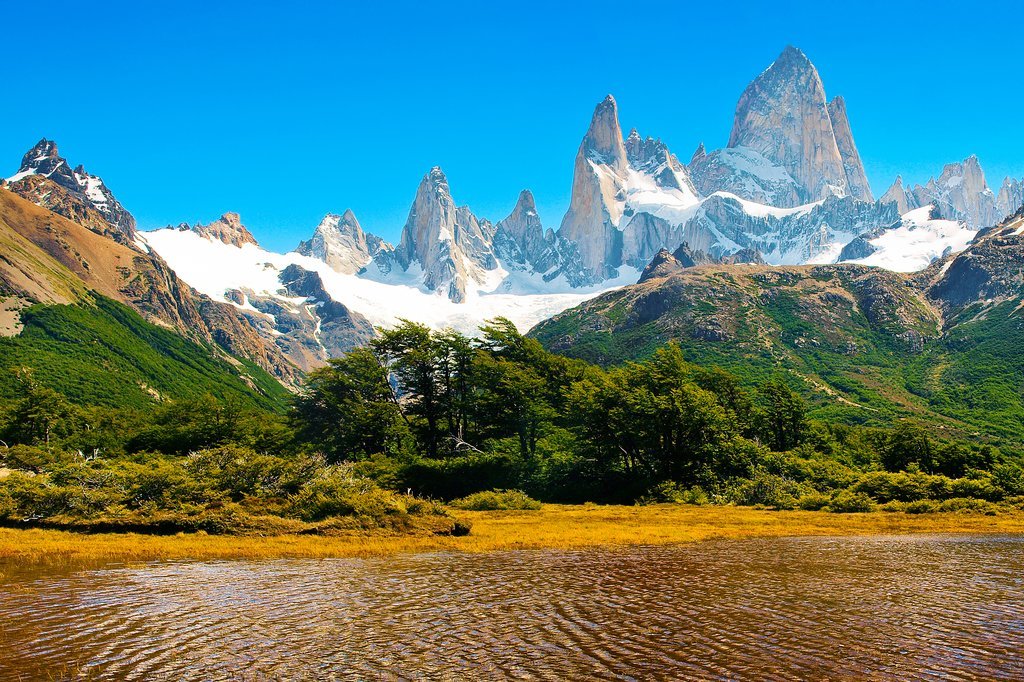Seasonal Planning for Patagonia Travel
Argentina and Chile are in the southern hemisphere, meaning that December through February are summer months (and peak travel time) while July is in the dead of winter. As a general rule, summer has the best weather, while fall and spring have the best prices and fewer crowds. Winter in Patagonia is an adventure: dress warm, and keep your schedule flexible in case of stormy weather. And no matter what time of year you go, plan for cold nights, sunny days, rain, and possibly snow—anything is possible!
| Season | Pros | Cons | Best for | Where to Visit |
| Mid-November to March (Summer) | Good hiking conditions. Sunny days. Glaciers and national parks are easily accessible. | Peak travel time; must reserve ahead for many hotels and activities. High prices. | Glacier trekking, hiking, visiting southernmost Patagonia | Torres del Paine, Tierra del Fuego, Parque Nacional Los Glaciares |
| April and May (Fall) | Beautiful fall foliage. Fewer crowds. Possible discounts. | Some businesses close for the season after summer. Whale-watching not possible off Argentina's coast. | Photography, wildlife viewing | El Chaltén, El Calafate |
| June to August (Winter) | Snow-covered landscapes. Few visitors. | Too cold to visit southernmost destinations. Winter weather may affect travel. | Skiing and snowboarding, solitude | Lakes regions, Península Valdés |
| September and October (Spring) | Fewer crowds; better chances for wildlife viewing. Discounted hotel rooms. | Some attractions still closed for the winter. | Hiking, whale-watching, wildlife viewing | Península Valdés, Parque Nacional Los Glaciares |
Mid-November to mid-March (Summer): Peak Travel Season

On both the Chilean and Argentine sides, this is Patagonia's prime time: summer is gorgeous here. All over Patagonia, summer is in full bloom, and you'll likely have plenty of bluebird days and night skies filled with stars. Summer is the warmest time of year, with highs in the upper 50s and low 60s Fahrenheit, and lows in the 30s. (It's also the windiest time of year—make sure to secure your tent and gear if you're planning on camping!)
The tradeoff: you'll share trails with tourists from all over the world, and your chances of wildlife spotting are somewhat diminished. This season brings the highest number of visitors to the region, so you'll need to plan ahead, whether you're booking tours or overnight stays in the refugios (shelters) of Torres del Paine. Prices are highest now, too; the earlier you plan, the more affordable options you'll have to choose from.
Still, it's a wonderful time to visit the southernmost sections of Patagonia, including Tierra del Fuego, which is too cold to visit in winter and even late fall or early spring.
Bottom line: Good weather, high prices. Planning ahead is essential.
Patagonia in November
Patagonia in December
Patagonia in January
Patagonia in February
Chat with a local specialist who can help organize your trip.
Mid-March to May (Autumn): Fall Foliage and Fewer Crowds

Thanks to the changing colors of Patagonia's famous landscapes, photographers love fall in southern Argentina and Chile. That said, you're better off traveling earlier in the season when temperatures hover in the upper 40s and 50s Fahrenheit—temperatures drop and the possibility of freezing rain and snow increases as late April turns to May.
There are many benefits to planning a trip to Patagonia during fall months. Cool weather on the earlier end of the season, is good for hiking in Tierra del Fuego and Torres del Paine, both of which are uncomfortably chilly to visit in winter. Hotels lower their high-season rates, most parks and activities are open for business, and you'll have fewer people to contend with on the trail (meaning better chances to spot elusive wildlife, like guanacos and pumas). The relative absence of tourists is especially noticeable in popular destinations like El Chaltén and El Calafate, which can be packed in summer.
Note that fall is the only season where a trip to Argentina's Atlantic coast isn't especially recommended: though the weather could be lovely, you'll miss the whale-watching season, which takes place from winter through early summer.
Bottom line: Beautiful scenery ideal for photography, fewer crowds. A relatively affordable time to visit.
Patagonia in March
Patagonia in April
Patagonia in May
June to August (Winter): Peace, Quiet, and Snow

Patagonia under a layer of snow? If you're up for an adventure, Patagonia is spectacular in winter. You'll want to skip the southernmost destinations where the weather can be extreme and hotels are closed for the season and focus instead on the lakes regions on either side of the Argentina-Chile border.
Temperatures are milder near the coast, but elsewhere in Patagonia, expect temperatures in the 20s, 30s, and 40s Fahrenheit, plus intermittent snowstorms and icy roads. Winter weather often impacts travel, with snow closing mountain passes and delaying flights and bus departures, so try to keep your schedule flexible.
Surrounded by frozen lakes and snow-capped peaks, Bariloche is charming in winter, and you'll have easy access to nearby ski areas. Or visit Península Valdés, when southern right whales play in the waters just off the coast of Puerto Pirámides and it's easy to join a whale- or penguin-spotting tour. Feeling extra adventurous? In July, Puerto Williams—the southernmost city in the world—hosts the Fiesta de la Nieve (Snow Festival), while Punta Arenas, also on the Chilean side, celebrates a Winter Carnival complete with fireworks and parades.
Bottom line: A good time to visit if you're interested in whale-watching or skiing. Be flexible, as winter weather affects travel.
Patagonia in June
Patagonia in July
Patagonia in August
September and October (Spring): Discounted Prices and Wildlife Watching

Spring in Patagonia is similar to autumn (see above), but with vibrant spring flowers instead of fall foliage. Expect warm days (highs in the 60s, lows in the 30s Fahrenheit) and chilly nights, lower prices, relatively small crowds, and deals on hotel rooms. Weather can be unpredictable, so bring warm clothes and waterproof gear.
This is an excellent season for wildlife. Whale-watching season is in full swing on Argentina's Atlantic coast, and you'll likely spot foxes, armadillos, and guanacos while hiking in the national parks. But be aware that this is less so as spring turns to summer: you'll have more and more tourists to contend with. Making reservations ahead of time is preferable in October, in particular.
Bottom line: Perfect for whale-watching. Bring layers, as weather fluctuates.
Patagonia in September
Patagonia in October
When's the best time to visit Patagonia?
It all depends on what you want to do. If you have your heart set on hiking the W in Torres del Paine, go in summer. If you're interested in photography (or if you're on a budget), opt for fall. Skiiers and off-the-beaten-path adventurers can try winter. And if you're dying to see whales up close, don't think twice: choose spring.
Ready to start planning your trip? Get inspired with our Patagonia tours and itineraries.
